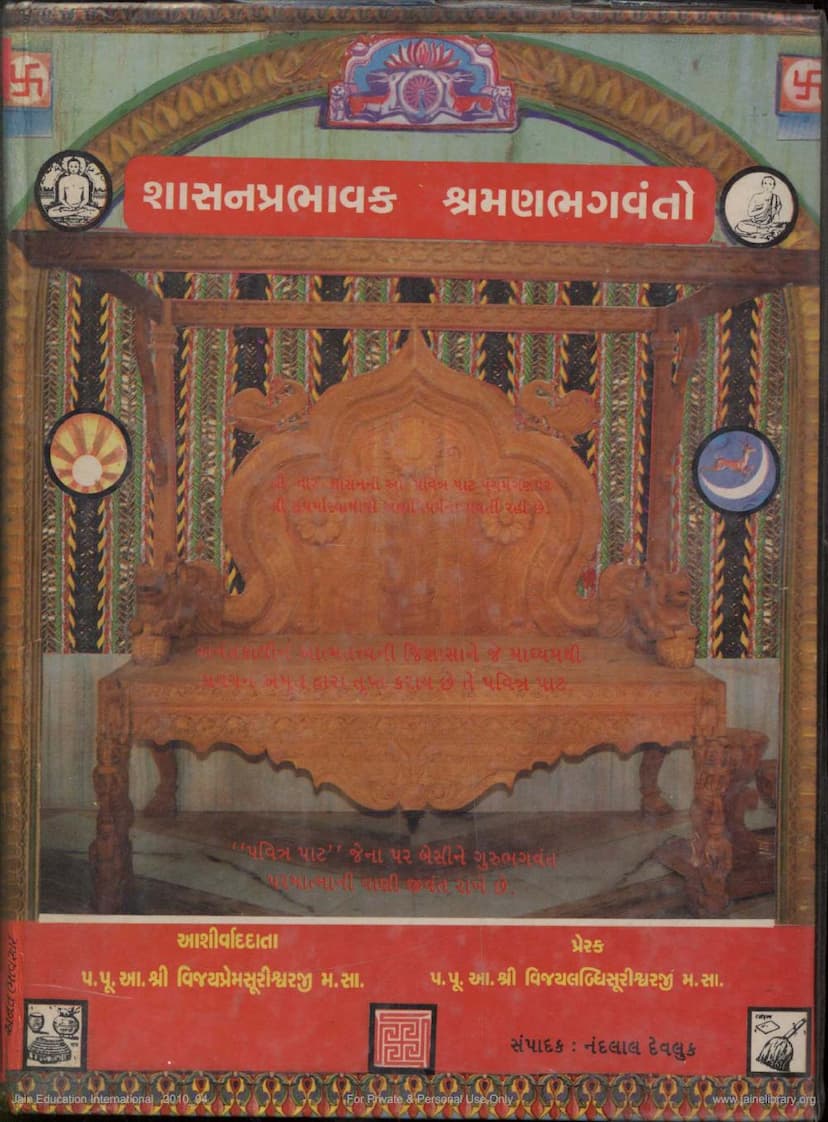Shasana Prabhavaka Shraman Bhagwanto Part 1
Added to library: September 2, 2025

Summary
This is a comprehensive summary of the Jain text "Shasana Prabhavaka Shraman Bhagwanto Part 1" by Nandlal B Devluk, published by Arihant Prakashan. The book, divided into two volumes, aims to document the lives and contributions of influential Jain monks who have significantly impacted and propagated the Jain faith.
Overall Scope and Purpose:
The book serves as a historical and biographical repository of revered Jain monks (Shraman Bhagwanto) who have been instrumental in the "Prabhavana" (propagation and glorification) of the Shasana (Jain teachings and tradition). It highlights their lives, spiritual practices, scholarly achievements, and contributions to the Jain community and wider society. The overarching goal is to present the glorious history of Jainism by showcasing the exemplary lives of these spiritual leaders.
Key Themes and Content:
The text covers a wide range of topics related to Jainism and its monastic tradition, emphasizing the role of the monks in its preservation and propagation. These include:
- The Importance of the Monastic Tradition: The text underscores the vital role of monks (Shraman) in preserving and spreading Jainism, referring to them as the adornments of the Shasana and the torchbearers of its principles.
- Historical Context and Challenges: It acknowledges the difficult times and challenges faced by Jainism throughout history, particularly in the current era influenced by Western materialism, violence, and corruption, which threaten the core values of Indian culture. Jainism is presented as a strong antidote and a beacon of hope in such times.
- The Legacy of Acharyas and Monks: The book details the contributions of numerous Jain Acharyas and monks, highlighting their dedication to spiritual practice (Sadhana), knowledge acquisition (Gyan), asceticism (Tapa), and their efforts in overcoming obstacles and defending the faith (Shasan-prabhavana).
- Key Figures and Their Contributions: The text likely profiles many prominent Jain monks, tracing their lineage through different Gachhas (sects or traditions). It mentions figures like:
- Early Acharyas: Extending from Sudharmaswami (disciple of Mahavir Swami) to various influential figures through different historical periods.
- Notable Acharyas: Figures like Acharya Kailassau Gyanmandir, Acharya Vijaypremsurishwarji, Acharya Vijaylabdhisurishwarji, Acharya Hemchandracharya (Kālikālasarvajña), Acharya Haribhadrasuri, Acharya Siddhasen Divakar, Acharya Heerasurishwarji, Upadhyay Yashovijayji, and many others are mentioned as key figures who influenced kings (like Kumarpal, Akbar), composed important scriptures, and established peace and righteousness.
- Specific Traditions: The text touches upon various Gachhas (Tapa Gachha, Khartar Gachha, Trikaya Gachha, etc.) and their prominent figures, demonstrating the diverse yet unified lineage of Jain monasticism.
- The Role of Devotion and Faith: The importance of devotion to the Tirthankaras, Siddhas, Acharyas, and the Jain faith itself is highlighted. It also pays homage to various divine beings and guardian deities of the Shasana.
- Jain Principles and Practices: The text implicitly and explicitly discusses core Jain principles like Ahimsa (non-violence), Anekantavada (multifaceted reality), and Syadvada (conditional predication). It also touches upon practices like Upvas (fasting), Ayambil (a specific type of fasting), and the importance of purity in diet and conduct.
- The Structure of the Sangha: It explains the concept of the Chaturvidha Sangha (four-fold community) and the significance of the roles of Acharya, Upadhyay, and Sadhu within it.
- Scholarly and Literary Contributions: The book emphasizes the immense literary output of Jain monks, including commentaries, philosophical treatises, devotional hymns, and historical accounts, which have enriched Jain literature and philosophy.
- The Ideal of Monastic Life: It portrays the monastic life as one of renunciation, self-discipline, knowledge pursuit, and unwavering faith, highlighting the efforts of monks in spreading ethical and spiritual values.
- The Role of Lay Disciples and Patrons: The text acknowledges the crucial support provided by lay followers and wealthy patrons who contributed financially and otherwise to the publication of scriptures, construction of temples, and support of the monastic community.
- The Concept of Kevala Jnana: The text briefly explains the state of omniscient knowledge (Kevala Jnana) as the ultimate spiritual attainment.
- The Tradition of Pilgrimage and Temples: The enduring legacy of Jain pilgrimage sites and temples is presented as a testament to the faith and efforts of past generations.
- The Importance of Scriptures and Their Preservation: The book emphasizes the meticulous efforts of monks in preserving and transmitting the Jain scriptures, including the various Agam Vachanas and their commentaries.
- The Goal of Salvation (Moksha): The ultimate aim of the spiritual path, leading to liberation from the cycle of birth and death, is presented as the driving force behind the monks' dedication.
Structure and Presentation:
The book appears to be a meticulously researched compilation, likely presenting biographical sketches of monks in a chronological or traditional order. The detailed inclusion of names, their respective Gachhas, and sometimes even their specific contributions suggests a comprehensive approach. The text also includes introductory and concluding remarks from prominent Acharyas and scholars, offering blessings, insights, and endorsements of the work. The presence of lineage charts (like the Tapa Gachha Shraman Vansh Vriksha) further indicates the depth of historical research.
Overall Message:
"Shasana Prabhavaka Shraman Bhagwanto Part 1" is a tribute to the profound legacy of Jain monks. It aims to educate and inspire readers by showcasing their unwavering commitment to Jain principles, their intellectual prowess, their spiritual depth, and their invaluable role in shaping and preserving Jainism for posterity. The book is a testament to the enduring strength and richness of the Jain tradition, as embodied by these revered spiritual guides.